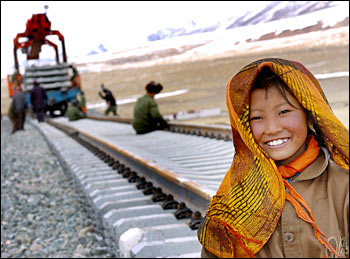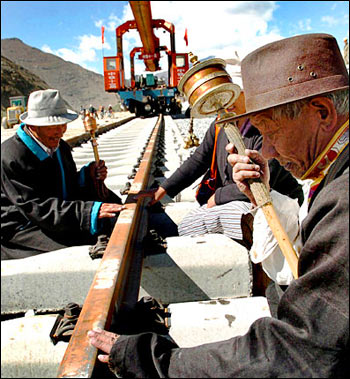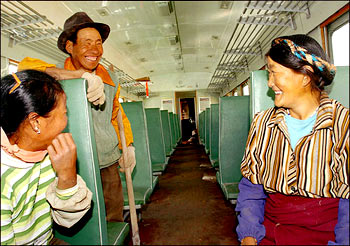|
The Golmud-Lhasa section of the Qinghai-Tibet Railway started its trial runs on March 1 and is expected to commence full-scale operations soon.
The railway extends 1,925 kilometers on the "roof of the world," linking Xining City in Qinghai Province and Tibet's regional capital Lhasa. The section from Xining to Golmud was opened to traffic in 1984 and construction of the Golmud-Lhasa section began on June 29, 2001.

Deputies of Tibet Autonomous Region attending the Fourth Session of the 10th National People's Congress, the country's legislature, from March 5 to 14 in Beijing expressed their expectations for the railway during their panel discussions.
"The completion of the railway is a big event for the Lhasa government and people because we've been waiting in expectation for many years," said Norbu Dondrup, the mayor of Lhasa, in an exclusive interview with china.org.cn on the sidelines of the ongoing NPC session.
With the pace of Tibet's opening up moving at an accelerated pace, the region, previously a mystery to the outside world, is beginning to share its beautiful landscapes, rich history and unique culture with more and more people.
"Tibet's economy has grown rapidly over the last few decades, but it is China's only region inaccessible by train. So, it still has a lot of catching up to do with the other provinces, municipalities and autonomous regions," the mayor said.
"The railway will bring rare development opportunities to Lhasa and its people."
For one thing, living standards of the local people will be greatly improved.

A frequently cited survey by China Tibetan Studies Center shows that the purchasing power of 100 yuan (about US$12.4) in Lhasa is equivalent to only 54 yuan (about US$6.7) in the coastal areas.
"The enormous transportation capacity of the railway will lower distribution costs and introduce a more varied range of commodities into Tibet."
This will raise the people's consumption levels and, more important, their needs will be better served.
Further, more distribution channels for Tibet's distinctive products will be created. Mayor Dondrup said that locally produced beef, mutton, Tibetan medicine, cordyceps, qingke (highland barley) wine, handicrafts and mineral water can be introduced to domestic markets, and even exported.
Last year, Lhasa received 1.2 million tourists, the majority of whom traveled by air. "If the railway is put into operation, a sightseeing train will be included to run on its tracks, and there will be at least 1 million more tourists each year," Mayor Dondrup noted.
"More tourism can further stimulate local consumption and investment."

Mayor Dondrup added that the railway would also help to strengthen ties between Lhasa and other cities in China, fostering enhanced bilateral exchanges in the science and culture fields.
Tibet is therefore preparing itself for these major development changes.
"We are now mulling Lhasa's 11th Five-Year Guidelines (2006-2010) for economic and social development in accordance with the railway layout and local conditions."
Local government plans to double gross domestic product (GDP), fiscal revenue and the average incomes of farmers and herdsmen, and to substantially improve the harmony between economy and society, the cultural quality of local residents and social undertakings by the end of 2010.
"We are constructing two railway stations, a freight and a passenger station, to transport people and goods from Lhasa to other parts of Tibet," Mayor Dondrup said.
Lhasa is also stepping up the construction of basic infrastructure around the railway stations, including power, water supply facilities and roads. Dondrup said that there are also plans to build three to four five-star hotels.
The State-level Lhasa Economic and Technological Development Zone is now inviting more investment, and aims to transform Lhasa into the bridge that links China and South Asia.
Mayor Dondrup acknowledged that all this development will have an impact on Tibet's fragile natural environment.
"Appropriate restriction measures are necessary," the mayor stressed. "If economic development negatively affects the environment, we will give priority to environment protection."

Backgrounder: Qinghai-Tibet Railway timeline:
1984 Xining-Golmud section begins operation
Jun 29, 2001 Construction of the Golmud-Lhasa section begins
Oct 15, 2005 Track laying for remainder of railway completed
Jul 1, 2006 Entire line scheduled to start trial operations
Jul1, 2007 Entire line scheduled to be officially fully operational
(China.org.cn by staff reporter Tang Fuchun, March 11, 2005)
|





